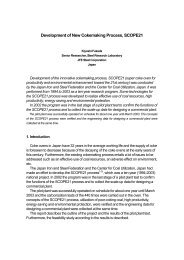Defining CCS Ready: An Approach to An International Definition
Defining CCS Ready: An Approach to An International Definition
Defining CCS Ready: An Approach to An International Definition
- No tags were found...
You also want an ePaper? Increase the reach of your titles
YUMPU automatically turns print PDFs into web optimized ePapers that Google loves.
Chapter 3: Transport <strong>Ready</strong> Plant <strong>Definition</strong>• Space needs around the plant for retrofitting of pipes and other infrastructuraldevelopment for ease of transport are still relevant based on technical and landdevelopments;• New approvals or permits for maintenance of transport readiness are obtained orrenewed as necessary;• Public engagement continues, and concerns of the community are addressed; and• Strong business relationships with transport equipment and service providers aremaintained.With the potential for significant increases in CO 2 transport, regula<strong>to</strong>ry agencies arebeginning <strong>to</strong> reconsider existing regulations for CO 2 transport. For example, the UK HSE isconsidering the hazards of and standards for the conveyance of liquid, dense phase, andsupercritical CO 2 in pipelines, and will develop CO 2 classifications and pipeline safetyguidelines accordingly. 82 Key <strong>to</strong> maintaining transport readiness will be moni<strong>to</strong>ring changes<strong>to</strong> regulations and best practice guidance.<strong>CCS</strong> <strong>Ready</strong> can be maintained by regular assessment of the following transport-relevantcriteria, and adapting CO 2 transportation plans as needed:• Project cost and timing considerations;• Technical developments with respect <strong>to</strong> viability, costs, and capacity needs;• Regula<strong>to</strong>ry framework pertaining <strong>to</strong> technical, environmental, route development, andhealth and safety requirements;• Public opposition and continuous engagement; and• Procurement sources and development of business relationships.3.4 RecommendationsWide deployment of <strong>CCS</strong> will likely require a transport regula<strong>to</strong>ry authority <strong>to</strong> approvepipeline construction and <strong>to</strong> oversee commercial practices and terms. As the CO 2 pipelineinfrastructure evolves, regula<strong>to</strong>ry policies will not only facilitate rights-of-way negotiationsbut also help provide assurance <strong>to</strong> pipeline developers for infrastructural developmentnecessary for CO 2 transport. 83Jurisdictions may wish <strong>to</strong> clearly designate a commercial regula<strong>to</strong>ry body for CO 2 pipelines(either with existing regula<strong>to</strong>ry agencies or a separate agency). For example, in the US,there is no national commercial regula<strong>to</strong>ry body for CO 2 pipelines, although the US FederalUS FERC regulates rates on interstate and gas pipelines. The composition of the transportedCO 2 and the construction and operation of the CO 2 pipelines and other transport methodswill also have <strong>to</strong> be regulated in some manner <strong>to</strong> ensure public safety and provide for easiertranshipments of CO 2 among various pipeline and other transport systems. It is also possible82 Paragraphs 83 and 84, pg. 30 of U.K. Department of Energy and Climate Change (U.K. DECC). (2009a). Carbon capturereadiness (CCR): A guidance note for Section 36 Electricity Act 1989 consent applications (Publication no. URN 09D/810).London, UK: Author.83 Carnegie Mellon University <strong>CCS</strong>Reg Project, Department of Engineering and Public Policy (CMU). (2009). Carboncapture and sequestration: Framing issues for regulation (<strong>CCS</strong>Reg Interim Report). Pittsburgh, PA: Author.23 February 2010 46
















